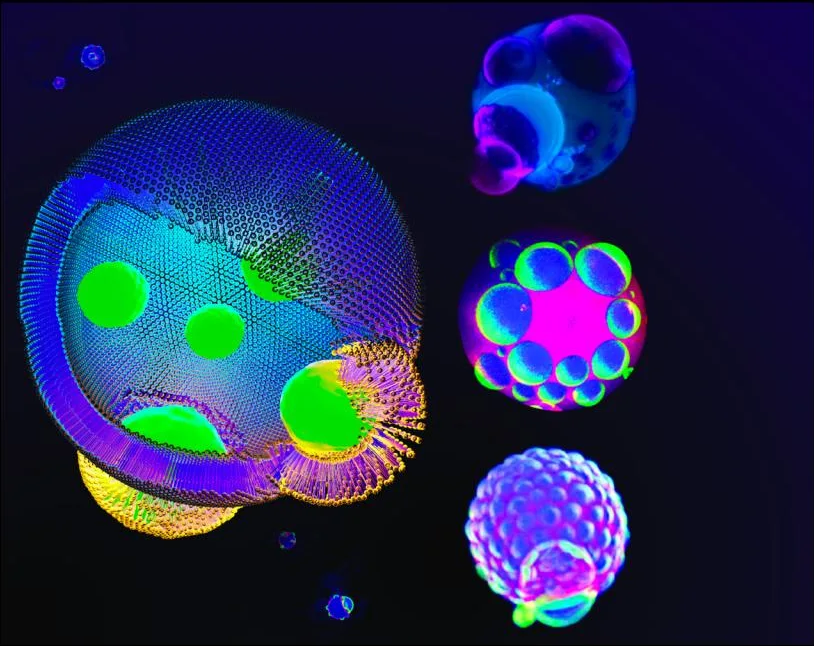Large, complex molecules crowd the inside of a living cell. Recent research into how these molecules instantaneously organize themselves could assist in understanding how cells manage their vital biochemistry in a crowded environment. This research could also shed new light on how the first living systems emerged and how their complexities evolved.
 Polymers that repel each other can spontaneously phase-separate inside artificial vesicles, like oils in a lava lamp. Interaction between droplets and the cell wall limits the size of the droplets and causes bubbling of the outside of the membrane. Image Credit: Wan-Chih Su, UC Davis.
Polymers that repel each other can spontaneously phase-separate inside artificial vesicles, like oils in a lava lamp. Interaction between droplets and the cell wall limits the size of the droplets and causes bubbling of the outside of the membrane. Image Credit: Wan-Chih Su, UC Davis.
Organelles, organized structures in eukaryotic cells, are surrounded by a lipid membrane. The mitochondria, which produce energy in cells, are one example. Researchers have discovered that, in addition to these organelles, groups of molecules can spontaneously form temporary organelles without a membrane to perform a particular task.
There may be simple physical mechanisms to create specialized ‘designer organelles’ on demand.”
Atul Parikh, Professor, Biomedical Engineering, University of California, Davis
Using a simple model of a cell, Parikh’s lab found how polymer mixtures can separate into phase-separated droplets, similar to oils in a lava lamp, and how these droplets interact with the cell membrane in unpredictable ways, such as impacting the cell's exterior structure. The findings were published in Nature Chemistry on July 6th, 2023.
Wan-Chi Su, a graduate student who collaborated with Parikh, developed artificial vesicles the size of living cells. These are primarily bubbles with a synthetic membrane containing water dissolved in two polymers. Because both polymers dissolve in water but repel each other, if they were mixed together and left alone, they would separate into two phases, similar to an unmixed salad dressing.
Su and Parikh discovered that when they removed the water from the vesicles, the polymers began to form isolated droplets, as expected. Instead of growing larger and larger droplets, they discovered that interactions between the polymer droplets and the inside of the vesicle membrane ceased growth, resulting in a mosaic of droplets.
Signaling on Outside of Cell
These interactions even had an influence on the outside of the vesicle, allowing a bubbling or “blebbing” effect. This appears to be an effect seen in living cells under certain conditions.
Coupling to the cell boundary prematurely stops phase separation and creates a mosaic of droplets. These 3D droplets inside the vesicle, interestingly, reorganize molecules in the 2D membrane, thus also signaling to the outside of the vesicle.”
Atul Parikh, Professor, Biomedical Engineering, University of California, Davis
The investigators are optimistic that the phenomenon is generalizable and not limited to this particular molecule combination.
According to Parikh, the work demonstrates how purely physical interactions—how polymers repel or attract each other—can give rise to complex organization in a simplified cell-like system.
We’re elucidating the physical and chemical principles behind biology. It might say something about how life may have come about in the first place.”
Atul Parikh, Professor, Biomedical Engineering, University of California, Davis
Parikh and coworkers intend to extend their research to more complex systems, such as living cells.
Source:
Journal reference:
Su, W.-C., et al. (2023). Kinetic control of shape deformations and membrane phase separation inside giant vesicles. Nature Chemistry. doi.org/10.1038/s41557-023-01267-1.